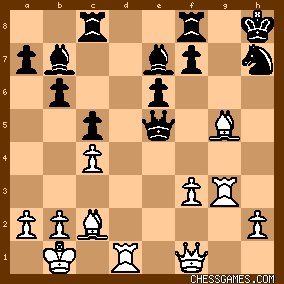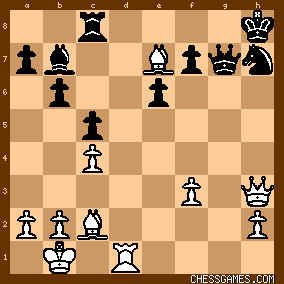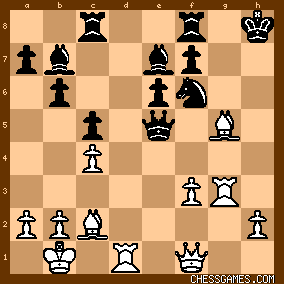| Jan-27-08 | | whiteshark: Looking at this game for quite a while I now think that <11...♕d5> is already the decisive mistake. <11...a5> looks like the only move to keep the position in balance. |
|
| Dec-27-14 | | Cheapo by the Dozen: White is down two pawns. If e5 were defended, Bxg6 would discover an attack that wins Black's queen. This suggests White's plan could be Nxg6/Bxg6/f4, probably in that move order. White could follow that up with Bxf6, which would not be opening himself up to mate at b2, then a discovered check retreating his surviving bishop to a safe square (probably all the way back to c2), followed by Qh3 (if Black's king runs to the edge). I'm not sure whether the f4 bump to Black's queen is more help for White than hindrance. I haven't seen yet what to do if Black's king runs for the center instead, but I note that the d1 rook makes it hard for the king to run far. I did check whether Black could decline the original knight sac, but it seems doing so puts him into an immediate material hole while leaving White with a lot of attacking chances. |
|
| Dec-27-14 | | M.Hassan: "Very Difficult"
White to play 20.?
White is 2 pawns down.
20.Bxg6! Qxe5 or else Queen is lost
21.Bxh7+ Kxh7
22.Qh3+ Kg7
23.Qh6+ Kg8
24.Bxf6+ Qxg3
25.Qh8#
Time to check and see the game
========
Not quite |
|
| Dec-27-14 | | thegoldenband: Oddly reminiscent of Lasker vs J Bauer, 1889, somehow. |
|
| Dec-27-14 | | patzer2: For today's Saturday puzzle solution 20. Bxg6!! (not 20. Nxf7?? Kxf7! 21. Bxg6+ hxg6 22. Rxd4 cxd4  ) 20... Qxe5 21. Bxh7+ Nxh7 (21... Kxh7
22. Qh3+ Kg8 23. Bxf6+ Qxg3 24. Qh8#) 22. Bf4+ Qg7 23. Rxg7+ Kxg7 24. Rd7 ) 20... Qxe5 21. Bxh7+ Nxh7 (21... Kxh7
22. Qh3+ Kg8 23. Bxf6+ Qxg3 24. Qh8#) 22. Bf4+ Qg7 23. Rxg7+ Kxg7 24. Rd7  gives White a discovered attack leading to a decisive double attack, when play might continue 24...Bf6
25. Rxb7 Rcd8 26. Qh3 Kh8 27. Bh6 Rg8 28. Rxf7 Rg1+ 29. Kc2 gives White a discovered attack leading to a decisive double attack, when play might continue 24...Bf6
25. Rxb7 Rcd8 26. Qh3 Kh8 27. Bh6 Rg8 28. Rxf7 Rg1+ 29. Kc2  . .White's winning combination actually begins with 17. f3!  setting up 18. Qf1! setting up 18. Qf1!  and 19. Bg5! and 19. Bg5!  . . Black's best chance at improvement may be in the early opening to middle game transition. Instead of counter attacking with the unsupported Queen with 11...Qd5 12. Kb1  , perhaps the Fritz idea of developing a counter attack with 11...a5!, when play might continue 12. Ne5 a4 13. a3 Bd6 = to , perhaps the Fritz idea of developing a counter attack with 11...a5!, when play might continue 12. Ne5 a4 13. a3 Bd6 = to  , makes sense. , makes sense. My personal preference in the French is an earlier divergence with the more popular 3...Bb4 or 3...Nf6, but there's probably nothing wrong with the 3...dxe4 line as it isn't significantly slower in development than these more frequently played lines. P.S.: Perhaps 18. Qf1! would make for a good Sunday puzzle candidate. |
|
| Dec-27-14 | | Swedish Logician: <thegoldenband>, I thought the same: sacrificial destruction of the pawn protection wall, after which the crucial move 24.Rd7 here is perfectly matched by Lasker's similar 22.Qd7 . |
|
| Dec-27-14 | | agb2002: White is two pawns down.
Black threatens 20... Qxe5.
White can put an end to the game with a knight sacrifice in two moves: 20.Bxf6 Bxf6 21.Nxg6 Qxb2#. But seriouly, this suggests 20.Bxg6, instead: A) 20... Qxe5 21.Bxh7+
A.1) 21... Nxh7 22.Bf4+ Qg7 (else 23.Bxe5 wins the queen for two pieces) 23.Rxg7+ Kxg7 24.Rd7 wins the queen for a rook and a knight. A.2) 21... Kxh7 22.Qh3+ Kg6 (22... Kg7 23.Qh6+ Kg8 24.Bxf6+ Qxg3 25.Qh8#; 22... Kg8 23.Bxf6+ Qxg3 24.Qh8#) 23.Bf4+ wins. A.3) 21... Kg7 22.Bf4+ wins the queen for two pieces. A.4) 21... Kh8 22.Bc2 (threatens 23.Qh3+)
A.4.a) 22... Nh7 23.Qh3 Qg7 24.Bf6 Bxf6 25.Rxg7 and mate soon. A.4.b) 22... Kg7(8) 23.Bf4+, etc.
A.4.c) 22... Be4 23.Qh3+ Kg7 (23... Bh7 24.Bxf6+ and 25.Qxh7#; 23... Nh7 24.Bxe4 wins) 24.Bf4+, etc. B) 20... hxg6 21.Rxd4 cxd4 22.Bxf6 Bxf6 23.Nd7 Bh4 24.Rg4 Be7 25.Nxf8 Kxf8 26.Rxd4 + - [Q vs 2B]. C) 20... fxg6 21.Rxd4 cxd4 22.Qh3 and Black can't protect the e-pawn. D) 20... Qxd1+ 21.Qxd1
D.1) 21... hxg6 22.Bh6 Rfd8 23.Qc2 looks winning. For example, 23... Nh5 24.Rxg6+ fxg6 25.Qxg6+ Kh8 26.Nf7#. D.2) 21... fxg6 22.Bh6 Rfd8 23.Qc2 as in D.1. |
|
| Dec-27-14 | | Dr. J: <agb2002> Perhaps somewhat surprisingly, one of your variations could plausibly end in a smothered mate: <20.Bxg6 ... D) 20... Qxd1+ 21.Qxd1 ...
D.2) 21... fxg6 22.Bh6 Rfd8 23.Qc2 [winning]> If instead 22...Nh5 23.Bxf8 Bxf8 24.Qd7 Ba6 25.Rxg6+ Bg7 26.Qxe6+ etc. (Black has no worthwhile alternatives at move 23 or 24, though he doesn't have to get mated this quickly.) |
|
| Dec-27-14 | | morfishine: No good for me, I kept trying to make 20.Bxf6 Bxf6 21.Bxg6 work, but was too stubborn to even look at the immediate 20.Bxg6 pathetic
***** |
|
Dec-27-14
 | | paulalbert: Was reasonably sure that Bxg6 followed by Bxh7ch was the way to go, but didn't get the followup variations correct. |
|
Dec-27-14
 | | Penguincw: Facepalm.
Even though I didn't spend much time on it, I anticipated 20.Bxg6 hxg6 21.Nxg6 fxg6 22.Be3. The only problem: I though it came with discovered check. D: On the bright side, I've never solved a Saturday puzzle before, so today shouldn't be any different... |
|
| Dec-27-14 | | patzer2: <morfishine><paulalbert> I didn't get it either. The analysis from my post above is based on a move-by-move look with Frtiz 12. My choice was to bail out with 20. f4!? when Fritz indicates best play goes 20...Qd8! 21. Bxg6 hxg6 22. Rxc8  to to  with an edge for White but no sure win. with an edge for White but no sure win. Apparently one purpose of 20. Bxg6!! is to force 20...Qxe5 to clear the d-file for the subsequent Rook fork (double attack) 24. Rd7  . . |
|
| Dec-27-14 | | varishnakov: I had some serious chess blindness in this problem. The first thing I looked at was 20.BxP but then I felt that even if the horse is immune, black has 20...QxR+ 21.QxQ RPxB when material is about equal, and I felt white's attack had dissipated. My computer politely let me know that in that line white continues with 22.Q-B2! with devastating attacks on black's KN3 and kingside that cannot be met. I settled with 20.P-B4 threatening to trap the queen, but then I blindly didn't notice that if I stick my bishop on K4, ...BxB+ is with check...which ruins my line completely. Oh well. |
|
| Dec-27-14 | | patzer2: <abg2002> After 20.Bxg6 Qxe5 21.Bxh7+ Kh8 22. Bc2! Nh7 (your variation A.4.a, diagram below),
click for larger viewI like 23. Bxe7 when play might go 23...Rg8 24. Qh3 Rg7 25. Rxg7 Qxg7 (diagram below) 
click for larger viewwhen (diagram above) 26. Bf6! forces mate (mate-in-ten per Fritz). |
|
Dec-27-14
 | | Sally Simpson: 
click for larger viewBecause you know it's a set play it must be Bxg6 letting the e5 Knight go and Bxh7+ with winning discovered checks up your sleeve. So puzzle move is Bxg6 and take it from there.
OTB I'd have gone for f4 holding the e5 Knight. (it's a good Knight, I can use that Knight and there are too many variations and expensive Queen judgements to carry out.) So after my OTB f4 I still have the Bxg6 threat on and you must remember your Nimzovitch (I think of very little else), the threat is stronger than the execution. I'll let him worry about Bxg6, see what he does and take it from there. |
|
Dec-27-14
 | | Jimfromprovidence: I had problems with the variation 20 Bxg6 Qxe5 21 Bxh7+ Kh8.
click for larger viewWhite has to spend a tempo to move the h7 bishop while down a piece and still keep a serious threat going. 
click for larger view 22 Bc2 (which took me forever to see is superior to 22 Bd3) is the best move, because it both threatens 23 Qh3 and 23 Rd7. 
click for larger viewBlack has two main choices here, giving up the queen by 22...Qxg3 or trying to defend with 22..Nh7. (The 22...Qxg3 path shows why for white 22 Bc2 is better than 22 Bd3.) |
|
| Dec-28-14 | | Cheapo by the Dozen: I think I saw enough of what happened in the game to claim that I solved it, EXCEPT that I abandoned the line because I didn't work through what happens if Black declines the bishop sacrifice at h7. In retrospect, that was silly ... but it was bad analysis that would surely have kept me from doing the right thing over the board. |
|
| Dec-28-14 | | Nova: Great puzzle! And equally great analysis from <patzer2> and <Jimfromprovidence> thanks! |
|
| Jan-07-16 | | PhilFeeley: I don't know whether this came before or after E Grivas vs A Braun, 2008, but Negi plays the attack very well, just like Grivas did in the other game. |
|





